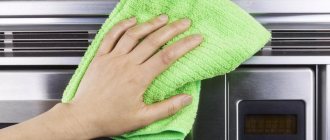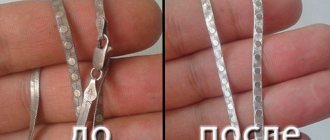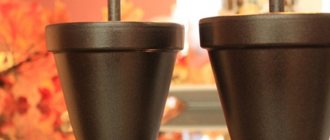Cleaning the inside of the refrigerator has its own specifics.
Since this device is intended for storing food, chemically active preparations cannot be used to remove dirt and unpleasant odors.
We have to look for safer hygiene products and methods. We will tell you how to properly wash your refrigerator so that it does not smell, and what approach to apply to No Frost systems and classic devices.
Why might there be a stench?
There may be several reasons for the appearance of an unwanted odor.:
- low-quality plastic case, capable of absorbing absolutely all “flavors”;
- non-compliance with the rules and shelf life of products - spoiled food and dishes emit a musty, poorly weathered smell;
- periodic melting of ice and clogging of drain holes - this provokes the proliferation of mold, which emits its own specific smell;
- storage of too spicy and aromatic products - smoked meats, fish, spices;
- a recently purchased unit is normal; the smell should disappear on its own over time.
In general, the “odor” appears as a result of infrequent cleaning, when microorganisms and fungus rapidly spread inside the unit.
Important! Unwashed food storage containers - egg trays, containers for vegetables and fruits - can emit an unpleasant odor.
Features of cleaning different models
Hygiene measures for the refrigerator compartment may vary depending on the model of the device. Moreover, newly purchased refrigerators must also be treated, even if a specific aroma is not felt from them.
No Frost System
No Frost is a special freezing system that eliminates the formation of ice on the walls of the freezer. This effect is achieved through innovative ventilation technology that prevents the growth of condensate. A No Frost refrigerator does not require periodic defrosting, but an unpleasant odor is a common occurrence for such devices .
The problem is caused by the condensate tray, which serves as a breeding ground for bacteria and a source of harmful fumes. The situation is aggravated by the fact that access to the tray is often difficult, and to clean it it is necessary to dismantle the back wall of the refrigerator.
The system requires periodic disinfection - approximately twice a year. To disinfect surfaces, you can use whiteness . It is diluted with water in a ratio of 1 to 10, a soft cloth or sponge is dipped into the resulting solution and all accessible areas are wiped.
Particular attention is paid to shelves, corners, and areas with mold - they are moistened with the solution and left for 10-15 minutes, after which they are wiped with a cloth.
Using a vacuum cleaner or a narrow long brush, clean the condenser located on the rear wall from dust. The drain hole, which often causes an unpleasant odor, is cleaned using a medical bulb or syringe, pouring water directly into the channel.
Regular models
Traditional models of refrigeration devices should be maintained according to the instructions. It must indicate the frequency of treatment and indicate the permitted cleaning products. For washing, it is recommended to use a soft cloth or dishwashing sponge .
Using detergent, clean all walls and shelves, moving from top to bottom. Particular attention will have to be paid to the door, small trays and containers where dirt and food debris accumulate the most. Armed with an old toothbrush, clean the rubber seal.
Important! Do not wash the door seal with vinegar or acids. If the elastic band has lost its elasticity, you can treat it with vegetable oil.
When the dirt has been removed, wipe all surfaces dry and leave the refrigerator open until completely dry. If the smell does not go away after washing, a variety of remedies and recipes will come to the rescue, which will be discussed below.
Prevention Tips
Now you know how to remove odors from the refrigerator at home, but it is also important how to prevent unpleasant odors from reappearing.
The frequency of cleaning depends on the type of cooling system.
Equipment with a No Frost system should be treated 2-3 times a year, while a drip system will require similar procedures every month.
Let us repeat once again that spoiled food should be thrown away immediately, and spilled juices, compote, milk, broths should be wiped up immediately.
You can leave a cracker of black bread or cut raw potatoes on a plate, changing them periodically.
Activated carbon, calcined in the oven, or a cup of ground coffee (the most inexpensive) also tends to absorb foreign odors.
In the freshness zone (lower vegetable tray), crumpled up thick paper will help remove the musty smell.
You can also use more modern methods.
A bactericidal ultraviolet lamp effectively kills reproducing microorganisms, mold and fungi, not only eliminating unpleasant odors, but also prolonging the freshness of products.
Preparation
It is permissible to start cleaning the refrigerator only after disconnecting the unit from the power supply. first set the temperature regulator to zero .
All food and containers are removed from the chamber, a thorough inspection is carried out, getting rid of expired and spoiled food. Perishable and frozen foods are placed in a bowl and placed in a cool, dark place or immersed directly in a bowl in a bath of ice and cold water.
All dirty containers and packaging are also washed, otherwise the smell will not go away after they are put back into the chamber.
You can speed up defrosting by spraying the walls with hot water from a spray bottle . You can place an open container or plastic bottles filled with hot liquid in the chamber. As the water cools, change it to hot water, and so on until the ice thaws.
All removable shelves, containers, and side racks will have to be removed. It is most effective to wash them separately - directly under running water or in a basin with soapy water.
How to quickly wash using folk remedies?
Safe cleaning, without the use of chemicals, will be provided by homemade preparations prepared according to folk recipes.
Vinegar
Regular vinegar does a good job of cleaning and removing foreign odors.
- Prepare a cleaning solution - vinegar with a concentration of 9% is diluted with water in a ratio of 1 to 1.
- Dip a clean cloth or sponge into the resulting solution and wipe all surfaces.
- Then you can walk through the same areas again, only this time with clean water.
- We complete the process by wiping with a clean cloth, after which the refrigerator is left with the door open for at least 3 hours so that the odors completely disappear.
Using vinegar you can do an excellent job of removing grease in the oven; instructions are in this article.
Soda
The safest, but at the same time one of the most effective cleaning agents is baking soda.
It can be used as a powder; you just need to first make sure that your refrigerator model can be washed with mild abrasives.
Soda solution will provide more gentle cleaning:
- Dissolve 2 tablespoons in a liter of water. spoons of soda.
- Remove all shelves and grates and wipe them with the resulting solution.
- Wash the entire inside of the refrigerator.
- Wash off the remaining soda with a rag moistened with clean water.
- Dry surfaces with a dry towel.
Soda will not only serve as a good cleaner, but will also disinfect all parts of the device. With it you can wash almost all household appliances and more. So, using soda you can easily and simply clean an electric kettle.
Lemon
Lemon juice acts like vinegar - the acid effectively breaks down fat, removes dirt and unpleasant odors.
The lemon is doused with boiling water so that it gives more juice, cut into two halves and one of them is squeezed well into a separate bowl.
The resulting juice is diluted with a liter of water and used as a detergent to wipe the internal and external walls of the refrigeration unit.
In general, citric acid is a universal cleaning agent. For example, you can use it to clean a microwave from grease, as described in this article.
Hydrogen peroxide
This medication is considered the most powerful in the fight against unpleasant odors. In the open air, it quickly evaporates, taking with it all the “aromas”.
Work progress:
- Dilute a teaspoon of hydrogen peroxide in a liter of clean water.
- Add a small spoon of vinegar to the solution.
- Carefully process all walls, removable parts and components.
- Ventilate the refrigerator.
The drug can also be used to irrigate particularly contaminated surfaces.
The prepared aqueous solution is poured into a bottle with a spray bottle and sprayed onto dirty areas. After 10 minutes, the dirt is removed with a soft, damp cloth.
Laundry soap
Soap has cleaning properties due to its alkaline composition, which is destructive to mold and germs, and also does an excellent job of removing dirt.
Instructions for use:
- Grate half a bar of laundry soap.
- Dissolve the shavings in a small amount of water until a paste is obtained.
- Apply the mixture to all areas and leave overnight to react.
- In the morning, rinse off the soapy mixture and wipe dry.
Advice! Treating the refrigerator with a weak solution of potassium permanganate will help get rid of the smell of rotten meat.
You can use laundry soap to clean the outside of your refrigerator; instructions are here.
Did our tips help you?
Not really
Afterword
Now you know the most effective methods of combating unpleasant odors from the refrigerator. And remember that preventing problems from occurring is easier than dealing with their consequences.
If you, like us, are interested in technical innovations for the home and are planning to buy new kitchen appliances, take a look at the article about how to choose a reliable refrigerator so as not to encounter problems in the future.
Share in the comments how you clean your refrigerator and deal with the formation of odors.
Using odor absorbers
Nowadays, the lines of household chemical manufacturers include a variety of products that can absorb odors in the refrigerator. They come in ball form that can be placed directly on shelves, or in cartridge form with a grid hanger.
They contain seaweed extracts, deodorizing additives, activated carbon, and mineral salts in the form of crystals - all of which effectively neutralize unpleasant “odors.”
One of the latest developments is an electric ionizer for a refrigerator . This is a device that saturates the chamber space with useful ions. They act not only as absorbers and fresheners, but also destroy pathogenic bacteria.
Some foods also have absorption properties, in particular:
- lemon - arrange citrus peels on shelves;
- salt - place in open jars;
- rice - place in a wide saucer;
- apple - cut and put on a shelf, change the fruit as it dries;
- black bread - cut into pieces and place in the chamber.
Aromatic spices and ground coffee can neutralize and eliminate the “odor.” They are scattered into small containers and placed inside the unit in random order. But you should keep in mind that all dishes and products can be saturated with such spicy aromas.
An interesting option is to combine lemon with baking soda. The lemon is cut into two halves, the pulp is scraped out, and a spoonful of soda is poured into the resulting cavity. This improvised air freshener is placed vertically on a saucer and placed in the refrigerator.
What can I do to prevent the device from stinking?
Any freezing systems require preventive cleaning approximately every 6 months.
During the shutdown, the unit will have time to “rest”, and the owner will carry out wet cleaning. In order not to spend a lot of effort on general cleaning of the refrigerator, its order should be maintained constantly:
- immediately remove dirty stains and prints without waiting for them to dry;
- keep egg containers and trays clean;
- If possible, store all dishes and products closed, especially those with a strong smell;
- To defrost meat and fish, use deep dishes so that melt water does not flow down the shelves;
- clean the drain hole once a month;
- monitor the expiration date of products, regularly get rid of “expired” ones and carry out an audit in the chamber;
- Do not store spoiled vegetables and fruits.
Once a week you can carry out hygienic cleaning without turning off the refrigerator. You just need to empty the shelves of food and quickly go over them with a wet napkin, grabbing the walls as well.
All the described methods for getting rid of odors in the refrigerator are quite effective. But it is much easier to prevent the appearance of “sweetness” - it is enough to simply provide the device with regular care and careful handling.
How to get rid of odor in the refrigerator freezer
Usually, the low temperatures of the freezer themselves protect it from the development of unpleasant odors - microorganisms and bacteria rarely multiply in extremely cold conditions. However, under certain circumstances, a stench can appear in the freezer.
Most often, the occurrence of stench is provoked by several reasons:
- Unstable operation of the electrical network. If the refrigerator is often and for a long time switched off from operation in emergency mode, frozen foods begin to defrost, and the moisture inside the freezer absorbs their smell.
- Unsealed packaging of meat and fish products. The rotten smell of meat and fish in the freezer occurs due to the fact that semi-finished products are packaged poorly. As soon as they are slightly defrosted, their smells mix with each other and form a persistent, unpleasant aroma.
- Accumulation of external odors inside the freezer. Each time the door is opened, air from the room or kitchen manages to penetrate into the freezer in small quantities and remains inside it. If you open the freezer at a time when the house smells strongly of cooked food, sooner or later a noticeable aroma will begin to emanate from inside the refrigerator.
You can wash the freezer from an unpleasant aroma in the same way as the main chamber of the refrigerator. But there is an important nuance - before washing the freezer, you must completely defrost it and remove the ice and snow from its walls. It is not recommended to scrape off ice deposits with a knife; you need to wait until the ice melts naturally.
The freezer compartment, freed from ice, must be washed with one of the household or specialized products and wiped dry. To prevent the appearance of stench in the future, you can not only wash the freezer, but also put a harmless flavor in it.
When using the freezer compartment, it is important to follow some rules:
- keep frozen foods in airtight bags or plastic containers with a tight-fitting lid;
- prevent emergency defrosting of semi-finished products;
- regularly remove snow “coats” and excess ice from the freezer;
- do not keep food in the freezer for too long; usually, after 4-6 months, most semi-finished products, if they do not spoil, lose a significant part of their taste and benefits.
It is also not recommended to place food close to each other in the refrigerator - there should be a small free space between meat, fish, frozen vegetables and ice cream.











